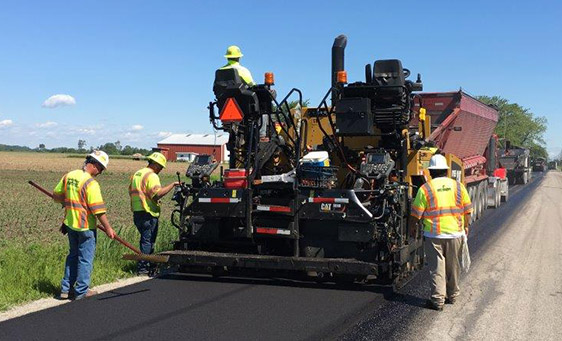Hot Mix Asphalt Paving: Elevating Commercial Parking Lot Requirements
Wiki Article
Unlocking the Secrets of Warm Mix Asphalt Technology
Checking out the depths of hot mix asphalt technology uncovers a world where specific solutions and thorough procedures converge to form our roadways and facilities. The blend of binders, aggregates, and fillers isn't simply a construction job however a strategic orchestration of toughness and performance. As we peer right into the elaborate dance of parts, a tapestry of strength and sustainability unravels. Yet what lies beneath this surface of asphaltic mastery, and what secrets wait to be introduced in the realm of paving innovations?Relevance of Hot Mix Asphalt
Warm Mix Asphalt plays an essential function in contemporary facilities development due to its durability and cost-effectiveness. As the most commonly used paving material for roadways, highways, and vehicle parking great deals, Hot Mix Asphalt uses a variety of advantages that add to its relevance in building and construction tasks.The longevity of Hot Mix Asphalt stems from its composition, which consists of aggregates, binder, and filler products that are carefully chosen and mixed to fulfill particular performance requirements. Overall, the relevance of Hot Mix Asphalt in framework development can not be underrated, as it proceeds to be a cornerstone of contemporary building and construction techniques.
Elements of Asphalt Mixes
The structure of asphalt mixes consists of meticulously picked accumulations, binder, and filler materials that are important for achieving particular performance needs. Accumulations are the primary component of asphalt mixes, offering stamina and stability. The binder, typically bitumen or asphalt cement, holds the aggregates together and offers adaptability and toughness to the mix.The mix and percentage of these parts play a substantial function in determining the quality and performance of the asphalt mix. Engineers carefully design the mix to satisfy details needs, taking into consideration factors like traffic quantity, environment problems, and sidewalk life expectancy. Proper choice and harmonizing of accumulations, binder, and fillers are necessary for producing long lasting, resilient asphalt pavements.
Mixing and Production Strategies

Once the aggregates are chosen, the binder, typically asphalt concrete, is included in bind the materials together. The binder's top quality and quantity significantly impact the mix's adaptability, resistance, and toughness to ecological variables. In angled parking addition, fillers like moisturized lime or Portland cement might be incorporated to boost certain attributes of the asphalt mix, such as its workability or wetness resistance.
During manufacturing, the aggregates and binder are warmed, commonly in between 250-325 ° F(121-163 ° C ), to help with blending and guarantee appropriate finishing of the aggregates. The blending process must be comprehensive to achieve a homogeneous combination that promotes the wanted performance features of the asphalt. Various strategies, such as batch blending or drum mixing, are utilized to achieve premium and constant asphalt blends for building and construction tasks.
Aspects Impacting Asphalt Efficiency
Elements affecting asphalt efficiency encompass a range of variables that affect the sturdiness, long life, and overall quality of asphalt sidewalks. One essential factor is the top quality of materials used in the asphalt mix.
Style considerations, such as pavement density and drain, are vital in guaranteeing the long-term efficiency of the asphalt sidewalk. By very carefully taking into consideration these contractors, variables and engineers can optimize asphalt performance and boost the solution life of pavements.
Sustainable Practices in Asphalt Technology

WMA permits for the production and positioning of asphalt blends at lower temperature levels compared to standard hot-mix asphalt, resulting in lowered energy usage and greenhouse gas emissions. The use of permeable asphalt blends can assist minimize stormwater overflow concerns by allowing water to penetrate through the pavement and right into the ground, advertising natural water filtering and recharge processes.
Verdict
To conclude, warm mix asphalt modern technology plays a critical function in contemporary infrastructure development because of its sturdiness and cost-effectiveness. By meticulously stabilizing components, employing correct mixing techniques, and considering different variables, designers can develop top notch asphalt mixes that withstand rush hour lots and rough climate condition. Embracing sustainable techniques, such as utilizing recycled materials and warm-mix modern technologies, better enhances the ecological kindness of asphalt modern technology.
Blending and manufacturing strategies in warm mix asphalt innovation include the accurate combination and processing of aggregates, binder, and fillers to produce a resilient and high-performance asphalt mix.Variables affecting asphalt efficiency include an array of variables that affect the durability, long life, and total quality of asphalt pavements. Lasting practices in asphalt technology incorporate different initiatives intended at minimizing the ecological effect of asphalt manufacturing and paving processes. By incorporating recovered asphalt pavement (RAP) and recycled asphalt tiles (RAS) into brand-new asphalt mixes, the industry can dramatically minimize the usage of raw materials and energy, while also reducing land fill waste.
WMA allows for the production and positioning of asphalt blends at lower temperature levels compared to traditional hot-mix asphalt, resulting in lowered energy intake and greenhouse gas exhausts.
Report this wiki page